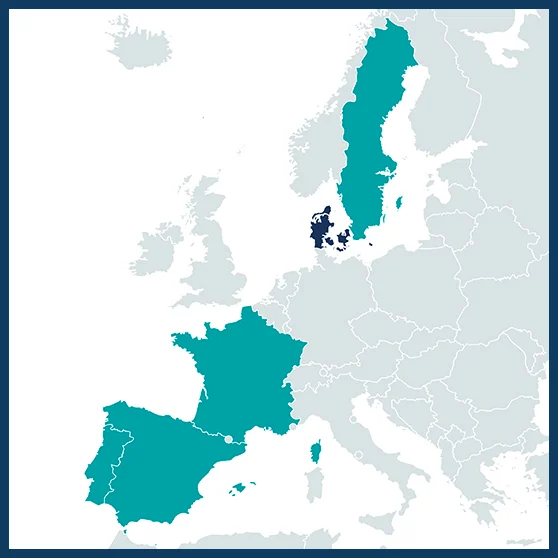01/04/2021 – 31/03/2024
€ 1,110,675
David LUSSEAU
davlu@dtu.dk
Coordinator: Aquatic Resources, Technical University of Denmark, Kgs. Lyngby, Denmark
Island Research and Environmental Observatory (CRIOBE), EPHE/CNRS/Perpignan University, Perpignan, France
Research, Madeira Whale Museum-Municipality of Machico, Caniçal Machico – Madeira, Portugal
Evolutionary Biology, Spanish National Research Council, Barcelona, Spain
Nonlinear Dynamics and Evolution, Mathematical Research Center, Cerdanyola del Valles, Spain
Aquatic Resources, Swedish University of Agricultural Sciences, Lysekil, Sweden

Currently, there are more than 17,000 marine protected areas (MPAs) around the world covering close to 9% of the oceans. Yet, only 23% of them have a clear management plan and only about 1% of them have had management effectiveness evaluations. Such management plans are crucial for the success of MPAs, but the development and implementation of those plans often meet financial and infrastructure obstacles. Even if guidelines exist, they do not systematically explain how to measure, monitor, and manage trade-offs between biodiversity targets and socio-economic impacts of MPAs. Particularly, there are currently no guidelines for developing adaptive plans to ensure the transformative change that MPAs are to bring for ecosystem restoration and conservation, biodiversity improvement, and to meet UN SDG targets. This is the key gap mpa4sustainability will address by conceptualising MPAs as interventions on complex socio-ecological systems and trying to appraise how they affect their journeys towards sustainability.
MPA4Sustainability will assess how existing MPAs can be used not only to achieve biodiversity targets, but also to maximise their contributions to the blue economy while respecting Nature. To do so, MPA4Sustainability will:
- Estimate how changes in biodiversity associated with MPA establishment, and embedding in existing spatial management, and management are related to ecosystem service exploitations. A retrospective approach will be used to estimate how biodiversity indicators are associated with ecosystem service exploitation richness, yield and resilience in existing MPAs depending on their characteristics and objectives.
- Estimate the dynamics of these socioecological networks of biodiversity and ecosystem service exploitation, the variety of states they can occupy, and the detection of possible cases of socio-ecological systems close to tipping points, using prospective analytical and computational approaches. There will be a focus on estimating the role of MPA management actions and human pressure in driving those changes.
- Assess whether readily available indicators can be used to monitor progress and adjust management of MPAs to ensure sustainability and the achievement of biodiversity targets.
- Carry out policy analyses to evaluate how networks of MPAs, that can come from varied regulatory frameworks, can have added value for regional biodiversity and ecosystem service targets.
MPA4Sustainability will advance knowledge of the form and function of coupled human-nature marine systems and how they can be exploited sustainably and efficiently monitored and managed.
- MPA4Sustainability will produce a practical Decision Support System and tool for managers and policy advisors. This Decision Support System will consist in guidelines accompanied by an open source, user-friendly simulation platform to use in the comprehensive task of developing an integrative MPA management plan to consider the socioecological trade-offs, identify management actions, develop a monitoring programme, and recognise how adjacent existing MPAs can be used synergistically.
- MPA4Sustainability will provide practical guidelines to implement the Decision Support System in three European case studies.
Current MPA design frameworks and guidelines assume that MPAs can fall along a protection continuum from fully-protected no-take areas to multiple use areas and that the closer to full protection an MPA is, the more it contributes to healthy oceans and benefit people. However, this continuum may suffer abrupt transitions between states due to non-linearity in socio-ecological systems. MPA4Sustainability will expand these guidelines, which influence regulatory implementations of European Directives – such as the Habitats, Birds and Marine Strategy Framework Directives –with a decision support system fulfilling the ambition the European Biodiversity Strategy and Green Deal. It will also contribute to IUCN’s Global Standards and User Manual of the Green List.
MPA4Sustainability will use three European case studies representing typical MPA configurations in terms of management complexity and management phases.
- Cerbère-Banyuls is an old MPA which has recently been embedded within the Golfe du Lion marine park with various protection zones, managed by multiple agencies.
- Madeira has established one of the newest Site of Community Importance to conserve highly mobile species. Its management plan needs to be integrated with existing adjacent MPAs.
- A mosaic of MPAs exist in Øresund, the strait between Sweden and Denmark. Øresundsvandssamarbejdet (stakeholder consortium) is exploring the potential to create a coherent network of MPAs.
- Innovation Fund Denmark (IFD), Denmark
- Agence Nationale de la Recherche (ANR), France
- Fundação para a Ciência e a Tecnologia (FCT), Portugal
- State Research Agency (AEI), Spain
- Swedish Environmental Protection Agency (SEPA), Sweden